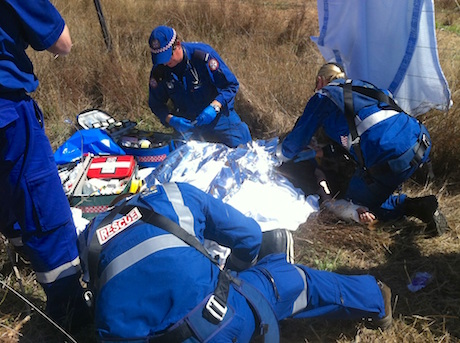Riders who have taken the First Aid For Motorcyclists course have helped themselves and other injured riders with their newfound knowledge and training.
And with Easter approaching, all riders who have done the course have been urged to brush up on their notes and skills.
First Aid For Motorcyclists instructors Roger Fance and Tracy Hughes sold their Sydney house in June 2015 and are taking the $78 course around Australia to reach as many riders as possible. So far they have trained more than 1000 riders in these essential emergency skills.

Among those was an injured 24-year-old rider who was able to talk the paramedics through the correct procedure to safely remove his own helmet, says Tracy.
“His mother rang and told us her son couldn’t attend the course with her, but when they got home she and her husband showed him what they’d learnt and how to remove a helmet,” she says.
“So when he was later involved in an accident he was able to talk the paramedics through the correct procedure.”
In another case, Tracy says a female rider hit a dog, crashed and was badly injured but another FAFM-trained rider was able to tend the scene, receiving high praise from the paramedics.
A Gold Coast rider who did the FAFM course was also able to successfully remove a helmet from an injured rider when the paramedics were unsure of the procedure. He sent this video to Tracy and Roger to use in their training.
https://youtu.be/RMl2cXbJDCk
“I was able to assist the ambulance personnel at the scene of a motorcycle accident in October and your instruction on the removal of helmets was very handy,” the rider says.
“The injured rider has given permission to forward the video to you for possible training purposes. His significant injury was to three vertebra.

“It is worth noting in the audio that he had a microphone attached to the lower section of the helmet which interfered with the removal of the helmet. The blood on his nose was the result of a cut from his glasses.”
Tracy says it is great to see in the video that the paramedics allowed Graham to manage the helmet removal and gave support with the rider’s neck.

“I am often surprised at the number of emergency services staff who are not familiar with helmet removal technique,” she says.
“The video is powerful stuff and a great testimonial to the importance of the right training to give you the skills and confidence in these situations.”
Riders who have completed the specialised motorcycle accident management training course have been urged to look over their course notes before Easter which usually has a spike in motorcycle accidents.
Course graduates can also now buy a 75mm stitched patch for $10 as a way to identify themselves at an accident scene as a rider who knows how to manage road trauma injuries.
It shows that the rider has the skills to handle the accident scene until emergency services arrive.
If you’ve completed the course, order your patch here.
Tracy and Roger have arrived in Western Australia for more course dates.
Click here to see when they will be in a town near you.




